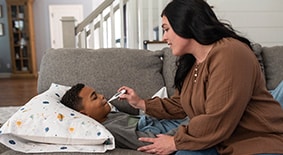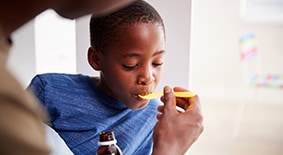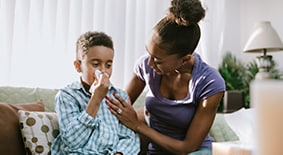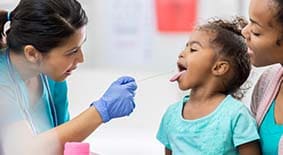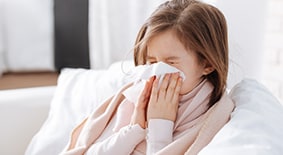Fever 101: Everything You Need to Know
Fevers can happen anytime, and they don’t always mean the same thing. Here’s what to do when your child’s temperature spikes.
It can be scary when your child has an abnormally high temperature. Most fevers are harmless, though, and parents can take comfort in knowing that some are even helpful—they’re a signal that your child’s immune system is working to fight infection.
In fact, many doctors agree that kids, from toddlers to teens, don’t even need to be given fever-reducing medicines unless they’re uncomfortable or in pain.
What constitutes a fever in kids?
A fever is defined as a temperature higher than 100.4°F (38°C).
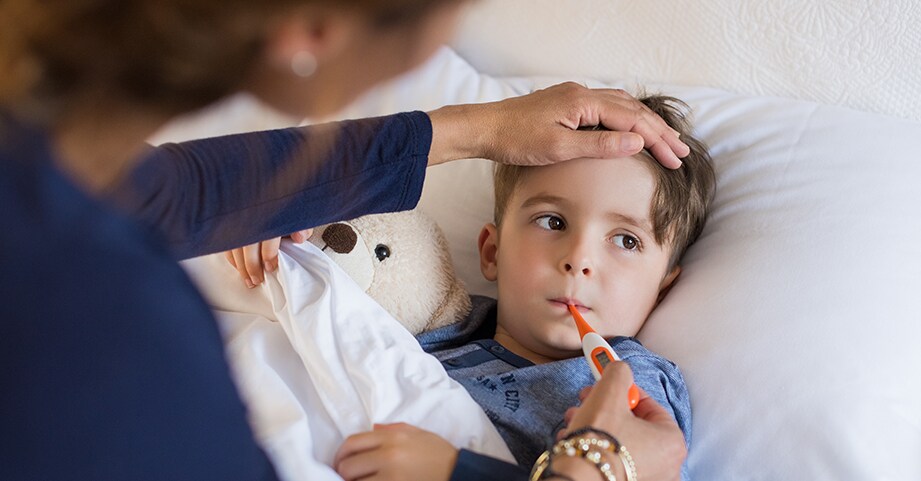
The way to treat fevers in kids can vary by age.
- Infants younger than 3 months of age whose temperature reaches 100.4°F (38°C) or higher should be evaluated by a doctor because fevers in infants can indicate a serious illness.
- In kids between 3 months and 3 years of age, a fever of 102.2°F (39°C) or higher requires a call to your pediatrician.
Doctors also recommend taking into consideration how your child looks and feels. Does he look or act sick?
“If your child has a fever but is still interested in playing, and is alert and smiling at you, his fever can probably be observed with at-home treatment,” said Deidre Stewart, MD, an area practice director for Children’s Healthcare of Atlanta Urgent Care. “Remember, a fever helps fight off infection, so you don’t necessarily have to give fever-reducing medicine right away. Don’t worry too much if he’s not eating the same amount as when he is healthy.”
If your child is weak, having trouble drinking or keeping down fluids, however, you should call your pediatrician.
If you think your child has a fever, take his temperature. You might assume your child has a fever if you touch his head and he feels warm, but this is not the best way to measure a temperature at home. The most reliable way is to use a digital thermometer.
There are several types on the market:
- Oral (under the tongue or armpit)
- Tympanic (in the ear)
- Rectal
- Temporal artery (on the forehead)
Taking a temperature rectally is the best way to get an accurate measurement, especially in infants. Temperatures taken orally tend to run about a half or a full degree lower than others. Whatever method you choose, read the instructions for your thermometer, and when reporting the temperature, be sure to tell your child’s doctor how you took it.
A high fever may not be a good indicator of how sick your child is. A simple cold or viral infection can cause a fever of 102°F to 104°F (38.9°C to 40°C) but isn’t usually a cause for worry. For infants, serious infections may cause no fever or even an abnormally low body temperature (below 97°F or 36.1°C). Usually what matters more than the fever is how your child is acting.
When should I call my child’s doctor about a fever?
Call your pediatrician right away if your child has a fever with:
- Rash
- Sore throat or earache
- Lasting diarrhea or repeated vomiting
- Signs of dehydration (urinating less than usual or no tears when crying)
- Refusal to consume fluids
Call 911 if your child has a fever with:
- Severe headache
- Stiff neck
- Complaints of light hurting his eyes
- Rash or purple spots that look like bruises on the skin
- Problems breathing
- Belly pain
- Sluggishness or trouble waking up
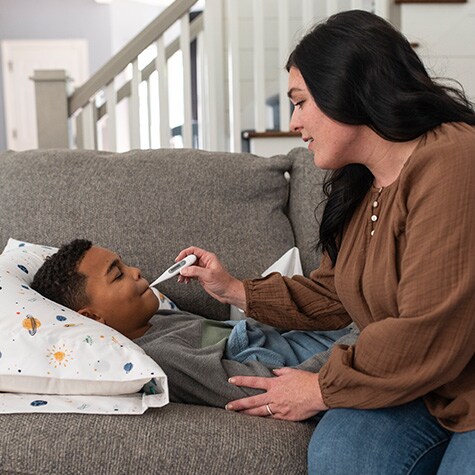
Where to go when your child is sick
If your child is sick or injured, it is important to know where to take them for care. Learn what can be treated at a pediatric urgent care center and a pediatrician's office.
Learn MoreA febrile seizure can occur when your child’s temperature spikes quickly. Symptoms may include loss of consciousness, twitching limbs or convulsions, and confusion or tiredness after the seizure.
“There is no temperature that automatically means your child will have a febrile seizure,” Dr. Stewart said. “How quickly your child’s temperature increases is more important than the actual height of the fever. Children most likely to have a seizure with fever are between 6 months and 6 years of age. This is most often due to viral illness.”
If your child has a febrile seizure, call your pediatrician.
If a fever is making your child fussy or uncomfortable, you can give him acetaminophen or ibuprofen. Follow the instructions on the label, and measure carefully based on your child’s weight, not age. If your little one is younger than 2 years old, call your pediatrician before giving him any medication.
Avoid giving your child aspirin for his fever, as this can cause Reye’s syndrome, a dangerous and rare disorder that causes brain and liver damage. Additional ways to treat your child’s fever at home:
- Dress him in lightweight clothing.
- Give him a bath in lukewarm water. Do not add rubbing alcohol to the water or apply it directly to your child’s skin. Rubbing alcohol is absorbed by the skin and can cause alcohol poisoning.
- Make sure his bedroom is a comfortable temperature—not too hot or cold.
- Offer plenty of fluids, ice pops and flavored gelatins to replenish fluids lost to fever.
- Make sure he gets plenty of rest.
Most doctors say your child can return to childcare or school when his temperature has been normal for 24 hours. If your child is younger than 2 with a fever that lasts more than 24 hours or older than 2 with a fever that lasts more than 72 hours, call your child’s pediatrician.
Helping You Navigate Common Childhood Illnesses
This content is general information and is not specific medical advice. Always consult with a doctor or healthcare provider if you have any questions or concerns about the health of a child. In case of an urgent concern or emergency, call 911 or go to the nearest emergency department right away. Some physicians and affiliated healthcare professionals on the Children’s Healthcare of Atlanta team are independent providers and are not our employees.
Contact Us 404-785-KIDS (5437)

